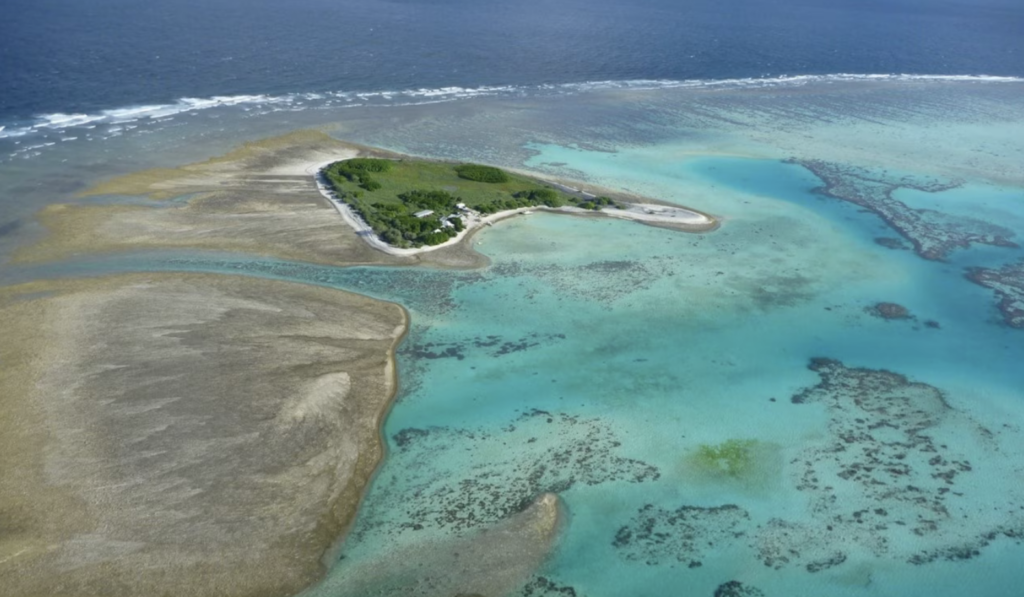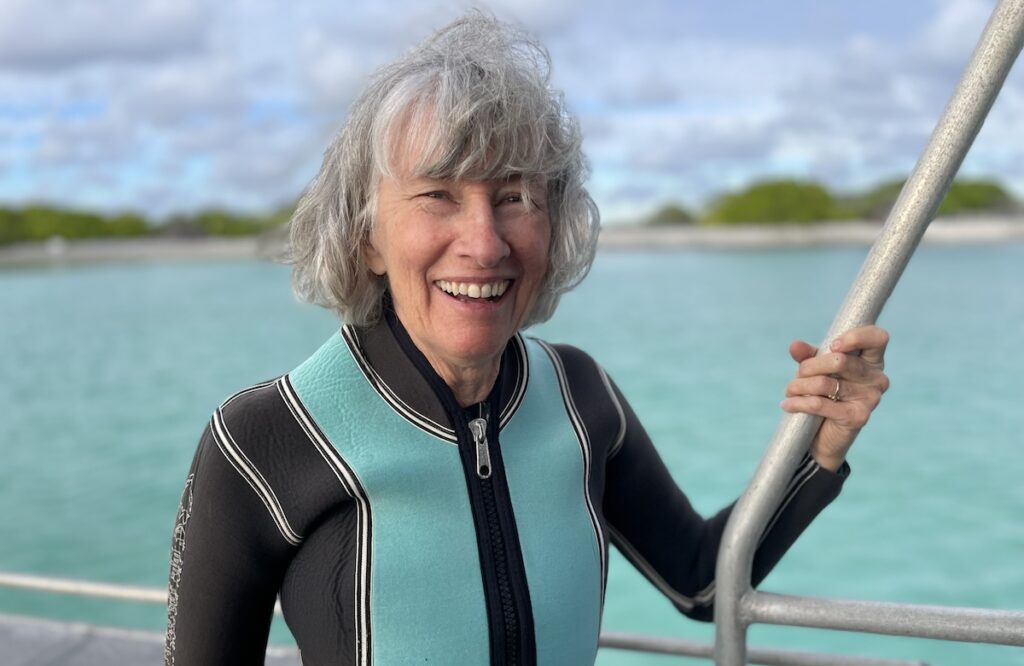Australia’s stories live on the Great Barrier Reef.
From the timeless relations of First Nations people, legacies and travesties of colonial invasion, of communities and industry; of corals and fish; of good characters and not – and lately, the daily theatre which is the performance of industry, science and politics as climate changes threaten ecosystem collapse.
The tides of Australian history, politics and culture flow through the Reef and its catchments, not immediately apparent from the shore but soon apparent when wading into its waters.
In a place like Australia where nature looms large in the national psyche, these currents are strong and consequential. How we remember the Reef and who are its main characters matters enormously to a nation so steeped in big nature.
While visibility is generally poor, women’s stories are in this place – and so the stories of Australia’s Great Barrier Reef and its women are entwined.
Given the current state of both – disrespected, abused, dying at the hands of those that love them? Inadequate government funding to address root causes? The contemporary connection is catastrophe. So, given the shared status of the Reef and Australian women, perhaps we could kill two fish with the one speargun.

A recent media release from Great Barrier Reef Foundation Managing Director Anna Marsden clearly thinks so
Anna Marsden, Great Barrier Reef Foundation Managing Director“The Reef has had a terrible summer and she’s hurting, but she is beautiful, resilient and with our help there is still hope to safeguard her future’.
It’s a Freudian slip. Or perhaps not?
The Great Barrier Reef Foundation has recently designated the Reef as female with email signatures proclaiming, ‘Help her survive the heat’ as an invitation to donate to their Reef Rescue Appeal.
We have come to accept the Reef ‘s story as one of science and corals, of industries and jobs, management, policies and law – and the ongoing party-political jostling therein. We remember protest and activism, from the Save the Reef campaign of the 1960’s to the more recent Fight for the Reef campaign.
This cacophony of noise, accusations and blame is allegory for the Reef and the stories we tell, and critically those stories we don’t. These untold stories lie beneath the ocean’s surface, far more interesting and instructive than what lies above. To know the Reef, both literally and metaphorically, it is best to dive deeper.
You’ll find Australian women there.
A story of guardianship
In the early nineties, Australian ecological feminist and philosopher Val Plumwood sailed in this very direction. In her seminal critique of the way nature has been thought in Western patriarchal culture, Feminism and the Mastery of Nature, she underscored the power of storytelling:
‘If we are to survive into a liveable future, we must take into our own hands the power to create, restore and explore different stories, with new main characters, better plots, and at least the possibility of some happy endings’.
Consider the unofficial ‘Queen of One Tree Island’, Alison Rickert – or at least that’s what I call her.
In 1971, Alison and her then partner, Steve Domm, laid the foundation stones for the One Tree Island Research Station. While on One Tree Island, Alison worked with research scientists including moving forty tonnes of concrete blocks underwater to create an artificial reef.

Cyclone Emily followed soon after, dismantling the blocks in place as an almost poetic response to foreign objects. Years later, Alison was able to explain the mystery concrete blocks to more recent arrivals.
Emily also dashed the racing ambitions of the 1972 Brisbane to Gladstone fleet and lives were lost. On One Tree, Alison could hear their distressed calls on their ship’s radio as she sheltered beneath an upturned dinghy for thirteen hours, with scuba gear (for survival if the island was inundated), curdled Ovaltine and nuts. There were no weather warnings then.
On our way to One Tree Island, Reef scientists fawn over Alison and I can see her surprise, ‘Oh, are you Alison? We’ve heard all about you’.
I’d lay fairly safe bets that most reading this won’t know of Alison as Reef royalty? Not a title she has selected for herself… and typical on both counts of Alison’s humility and the national memory.
When we arrive on One Tree, Alison, now in her late seventies, is all stories and heart. She recounts those early years, of adventure and isolation, of highs and lows – of staying out on the Reef, alone, waiting for tides, ‘sleeping like a cat’ so she could collect water samples – and of seeing a Reef the likes of which I will not.
Alison’s story is one that epitomises the entanglement of the Reef and Australian women – and there are many more, waiting to be told.
A sole parent in the early 1970’s, Alison found no institutional support for her and her young daughter to pursue her Reef ambitions. Moreover, the kind of Reef science that dominated then – and still – did not inspire her. She wanted to talk to people and communities – that is the human, social and cultural dimensions of the Reef.
So do I.
It’ll be fifty years of internal self-doubt before Alison recognises her personal Reef story speaks to a larger Reef politics.
… It’s really interesting for me to talk about it…I’d always put it down to I just lacked ambition. But I think it’s more than that. I couldn’t see a pathway forward, that would honour what I felt about the Reef, and what I felt about nature, it just was too narrow. And I always kind of dismissed myself as being kind of dilettante. And, you know, that I didn’t have what it took to be a research scientist, like other people did. But now, reflecting on it… now, I’m seeing it was much more.
The recognition is both therapeutic and traumatic. Hers is both an extraordinary and familiar tale.
One more trip?
Sharing these stories with scientists on One Tree Island, the women nod their heads knowingly, heard and seen. Quietly, good Australian men recount stories of women in their lives who, either in the Reef field or not, have been denied and dismissed because of their gender.
We agree that it is knowledge of the social system and not the ecosystem that threatens the Reef. But this is not a simple choice – it is the relations between the social system and the ecosystem that is ‘hurting’.

Reef science can only tell us half the story, our women tell the rest. And our responses to both are weakened by the suppression of women’s voices and their achievements.
Recently and just weeks before our departure, Alison decides she will not be joining me on this trip to One Tree Island. We’ve heard the news about the mass coral bleaching. Having spent a lifetime carrying this little island deep in her heart, it’s too much to break.
It’s breaking all our hearts.
The easy pick is more accusations, more failures and certainly in the Reef space, more terrible smug ‘we told you so’, as though this is helpful. It’s not.
Within Alison’s story, we find something far more useful – courageous pathways to healing and repair that simultaneously rewrite the Reef and Australian women.
Together these currents amplify women’s work, expertise and authority in the stories we tell about the Reef.
In Australia, this matters. And it is certainly not something we have tried or funded before.
This article draws upon the authors ‘Women of the Great Barrier Reef’ Project with research partner Dr Deb Anderson, Monash University



